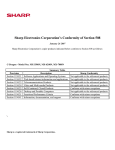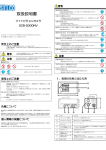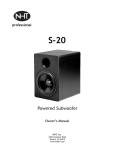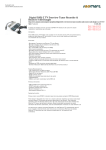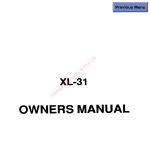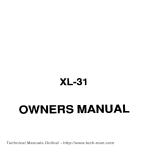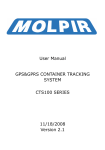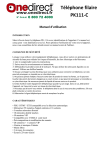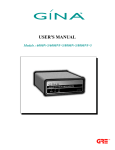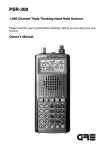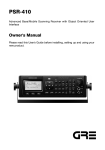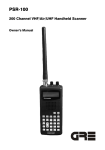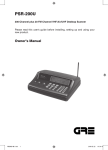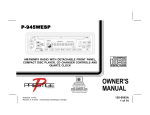Download User Manual - GRE America Inc.
Transcript
USER'S MANUAL Models : 5000N/5000NV/7000N/7000NV TM General Information GINA User’s Manual General Information Introduction This document is the User’s Manual for the GINA transceiver. NOTE: Read this manual completely before you try to use any GINA product. GINA Models GINA 5000N / 5000NV Model 5000N is a standard GINA transceiver. Model 5000NV has an additional voice handset for audio communication. GINA 5000N receives and transmits data in the ISM band of 902 to 928 MHz in half duplex mode. The 5000N has a standard RS-232 serial data interface that can be driven asynchronously at rates from 1200 through 19.2 Kbps (Optional 38.4 Kbps). GINA 5000N is autobauding and does not require any speed adjustments between it and the DTE device. It automatically synchronizes on any speed to 19.2 Kbps (Optional 38.4 Kbps). GINA 5000N is designed to replace a RS-232 cable connected to a distant device. It is plug and play transparent link to any device with a RS-2332 serial interface. There are no special setups required. GINA 5000N is a highly secure spread spectrum radio. It does not packetize or perform any error correction and is transparent. GINA 5000N being completely transparent allows any custom communication protocol to be used. Synchronous units at 19.2 Kbps are available as an option. GINA 7000N / 7000NV Model 7000N is a standard GINA transceiver. Model 7000NV has an additional voice handset for audio communication. GINA 7000N receives and transmits data in the ISM band of 2.404 - 2.478 GHz in half-duplex mode. GINA 7000N utilizes a standard RS-232 serial data interface that can be driven asynchronously at rates from 1.2 through 19.2 Kbps (Optional 38.4 Kbps). GINA does not require any synchronization between it and the DTE device. It automatically synchronizes on any speed to 19.2 Kbps (Optional 38.4 Kbps). GINA 7000N will transmit at the same speed as your asynchronous RS-232 device. GINA 7000N is designed to replace a RS-232 cable connected to a distant device. It is a plug and play transparent link to any device with a RS-232 serial interface. There are no special setups required. 1-1 ©1999 GRE America, Inc. All rights reserved. This material is the property of GRE America, Inc. Copying or reproducing this material is strictly prohibited. All violators shall be prosecuted to the fullest extent of the law. 7/99 (rev. 5) General Information GINA User’s Manual System Requirements For all GINA models, the only system requirement is an EIA232 (RS-232) peripheral or a personal computer (PC). When using a PC, any communications software package such as BitCom©, Procomm©, Crosstalk©, Windows 95/98© Hyper Terminal or any compatible communications package can be used. What is GINA? As shown in Figure 1-1, GINA is a high frequency data radio using spread spectrum technology. GINA receives and transmits data in the ISM band of 902-928 MHz or 2.404 - 2.478 GHz. GINA has standard data interfaces that can be driven at rates from 9.6 to 38.4 Kbps (Kilobits Per Second) depending on the model. GINA is a plug and play transparent link. There are no special setups required. GINA is a highly secure spread spectrum radio. GINA being transparent allows most custom communication protocols to be used. Figure 1-1. The GINA Transceiver Spread Spectrum Technology GINA uses spread spectrum technology, a technique originally developed by the U.S. military during World War II, to prevent the jamming of communications signals. Spread spectrum technology uses a narrow bandwidth radio frequency and spreads it over a wider portion of the bandwidth. Since the signal is spread out over the band, it renders narrow band jammers virtually ineffective. Additionally, the spread spectrum band can be used with low probability of interception, which is an ideal method of communication since it is ‘radio silent’ to a conventional receiver. 1-2 ©1999 GRE America, Inc. All rights reserved. This material is the property of GRE America, Inc. Copying or reproducing this material is strictly prohibited. All violators shall be prosecuted to the fullest extent of the law. 7/99 (rev. 5) General Information GINA User’s Manual Advantages of Spread Spectrum Technology Spread spectrum technology has many advantages. Among them are: • • • • • • System flexibility. Additions can be made easily. Interference immunity. Spread spectrum radios are immune to noise. Error-free communication. Automatic error detection is built into some models. Cost. Spread spectrum technology is inexpensive compared to an equivalent hard-wired installation. Data throughput. Spread spectrum technology is a transparent, real-time, point-to-point, and point-to-multipoint wireless network. Multi-channel. Spread spectrum radios have multiple channels that can be dynamically changed with software. It allows for repeaters, redundant base stations, and overlapping antenna cells. A great advantage is in the dynamic control of radio signal ‘peaks’ and ‘valleys.’ A typical spread spectrum radio signal is shown in Figure 1-2. Figure 1-2. Spread Spectrum Radio Signal A typical narrow band signal is shown in Figure 1-3. Figure 1-3. Narrow Band Radio Signal Definitions of Terms 1-3 ©1999 GRE America, Inc. All rights reserved. This material is the property of GRE America, Inc. Copying or reproducing this material is strictly prohibited. All violators shall be prosecuted to the fullest extent of the law. 7/99 (rev. 5) General Information GINA User’s Manual DATA INTERFACE — The asynchronous interface port provided for connectivity is a EIA-232 (RS232) standard. DIRECT SEQUENCE — Direct sequence is a technique that takes a narrow-band signal and spreads it over a broader portion of the radio frequency band. KEY-UP TIME — The time that a radio requires when switching from transmit to receive and vice-versa. There is no key-up time required due to an internal buffer. Except for Models 5000N and 7000N, data can be received and transmitted through the RS-232 port simultaneously in a full duplex mode using TDD (time division duplex). NOTE: Key-up time and spreading code length are interrelated. In a direct sequenced technique, the spread sequence system must (in real time) attempt to match its despreading code with the incoming radio signal in order to determine the validity of the data. The longer the spreading code, the longer the receiver must search before it can determine that a valid data signal is being transmitted. SYNCHRONIZATION — Applied each time that the radio switches between transmit and receive, synchronization produces direct overhead on each transmitted message, thereby reducing radio efficiency. In applications involving very long, constant messages (such as a large file transfer), synchronization time becomes less of a deciding factor. MULTIPATH — Radio signals may take several paths to reach the intended receiver. The receiver must sort out the main path from all the ‘ghost’ images. The longer the spreading factor and/or the faster the raw data rate, the more difficult (and eventually impossible) it is to sort out the signals, resulting in a loss of robust communication. NUMBER OF CHANNELS — The number of channels varies per GINA model. Models 5000N, 5000NV have 21 channels provided in the 902 - 928 MHz frequance range. Models 7000N, 7000NV have 37 channels provided in the 2.404 - 2.478 GHz frequency range. Note that the channels are overlapping and, depending on the unit separation, only one channel may be used. PROCESSING GAIN MEASUREMENTS — Since processing gain is a function of the RF bandwidth of the transmitted signal compared to the bit rate of the data, the theoretical calculation is: 10Log(Spreading Code Rate) x (Main Lobe Factor) RF Data Rate NOTE: Assuming that the RF main lobe of [sin x/]2 for direct sequence is 0.88 (main lobe factor) times the bandwidth spreading code clock rate. 1-4 ©1999 GRE America, Inc. All rights reserved. This material is the property of GRE America, Inc. Copying or reproducing this material is strictly prohibited. All violators shall be prosecuted to the fullest extent of the law. 7/99 (rev. 5) General Information GINA User’s Manual RANGE — The communication distance between GINA’s may vary according to environment and application. (Robustness and range are almost interchangeable terms; robustness and range vary according to the antenna system used.) RAW DATA RATE — Response time of data transmission/reception. The raw data rate is factory set to 128 Kbps. ROBUSTNESS — GRE America, Inc. believes that an RF link should be ‘as good as wire.’ Robustness is closely related to range. Variables for robustness and range include: • • • • • Transmitter Output Power Receiver Sensitivity Spreading Code Length Raw Data Rate Antenna Configuration NOTE: Spreading Code Length, Raw Data Rate, Robustness, and Multipath are interrelated; all terms are defined in this section. SPREADING CODE LENGTH — A shorter spreading code length results in better performance in measurable areas such as cost, actual data throughput, size, range, and robustness. A longer spreading code length reduces the possibility of unintended signal interruption and/or regulatory implications. GRE America has taken all the above criteria and used a spreading code length of 127 chip with four different codes selectable by channel. SYSTEM RESPONSE TIME — Raw data rate, reflected by transmission response time. The minimum response time is 12 msec. FCC Requirements The FCC has allocated the frequencies between 902 – 928 MHz and 2.404 and 2.478 GHz for use with spread spectrum technology and does not require the end user to obtain an FCC license to operate a GINA transceiver. NOTE: Professional installers who replace GRE-provided whip antennas with one not approved by GRE America, must obey FCC regulations concerning effective radiated power in the U.S. or the effective rules in the destination country relating to ERP. For detail specifications, refer to FCC Rules Part 15.247. 1-5 ©1999 GRE America, Inc. All rights reserved. This material is the property of GRE America, Inc. Copying or reproducing this material is strictly prohibited. All violators shall be prosecuted to the fullest extent of the law. 7/99 (rev. 5) General Information GINA User’s Manual FCC Statement This equipment has been tested and found to comply with the limits for a Class B digital device, pursuant to Part 15 of the FCC Rules. These limits are designed to provide reasonable protection against harmful interference in a residential installation. This equipment generates, uses, and can radiate radio frequency energy and, if not installed and used in accordance with the instructions, may cause harmful interference to radio communications. However, there is no guarantee that interference will not occur in a particular installation. If this equipment does cause harmful interference to radio or television reception (which can be determined by turning the equipment off and on) the user is encouraged to try to correct the interference by one or more of the following measures: • • • • Re-orient or relocate the transceivers. Increase the separation between equipment and transceivers. Connect the equipment into a different outlet or circuit different from the one where the receiver is connected. Consult a dealer or an experienced radio technician for help. Shielded cables and I/O cords must be used for this equipment to comply with relevant FCC regulations. Changes or modifications not expressly approved in writing by GRE America, Inc. may void the user’s authority to operate this equipment. Customer Support If you need answers to technical questions or require information about product updates, please contact GRE America’s Technical Support Team at: Tel: (650) 591-1400 Fax: (650) 591-2001 (800) 233-5973 (outside California) Between 8:00 A.M. and 5:00 PM, Pacific Time Email : [email protected] Product Returns If, after speaking to a technical support person, it is determined that your GINA unit requires servicing, call GRE and request a RMA number for repair and return units. Write the RMA number on the outside of the shipping box for reference. NOTE: Units returned without an RMA number will not be accepted. 1-6 ©1999 GRE America, Inc. All rights reserved. This material is the property of GRE America, Inc. Copying or reproducing this material is strictly prohibited. All violators shall be prosecuted to the fullest extent of the law. 7/99 (rev. 5) General Information GINA User’s Manual For further information, please write us at: GRE America, Inc. 425 Harbor Boulevard Belmont, CA USA 94002 Attn: Customer Support Safety Considerations For your safety, here are some things that you should do and not do: DO read this manual completely before using GINA. DO follow all instructions carefully. DO use the same caution with GINA as you would use with any electrical appliance. DO NOT try to use GINA for purposes for which it was not intended. DO NOT locate GINA in an area that does not have adequate ventilation for cooling. DO NOT use a ‘universal’ battery adapter with GINA. Only use the adapter supplied with the unit. 1-7 ©1999 GRE America, Inc. All rights reserved. This material is the property of GRE America, Inc. Copying or reproducing this material is strictly prohibited. All violators shall be prosecuted to the fullest extent of the law. 7/99 (rev. 5) 5000N, 5000NV, 7000N,& 7000NV GINA User’s Manual GINA Models 5000N, 5000NV, 7000N, & 7000NV Overview Models 5000N and 7000N are standard GINA transceivers. Models 5000NV and 7000NV have an additional voice handset for audio communication. GINA 5000N receives and transmits data in the ISM band of 902 to 928 MHz in half-duplex mode. GINA 7000N receives and transmits data in the ISM band of 2.404 - 2.478 GHz in half-duplex mode. GINA models 5000N and 7000N have a standard RS-232 serial data interface that can be driven asynchronously at rates from 1200 through 19.2 Kbps (Optional 38.4 Kbps). GINA 5000N/7000N does not require any synchronization between it and the DTE device. It automatically synchronizes on any speed to 19.2 Kbps (Optional 38.4 Kbps). GINA 5000N/ 7000N will transmit at the same speed as your asynchronous RS-232 device. GINA 5000N/7000N is designed to replace an RS-232 cable connected to a distant device. It is a plug-and-play transparent link to any device with a RS-232 serial interface. There are no special setups required. GINA 5000N/7000N is a highly secure spread spectrum radio. It does not packetize or perform error correction and is data transparent. GINA 5000N/7000N being transparent allows custom communication protocol to be used. Synchronous units with data rates to 19.2 Kbps are available as an option. Operation This section contains operating instructions for the GINA transceiver, including controls and indicators, timing considerations, DTE requirements, channel selection, and voice operation (Models 5000NV and 7000NV only). 2-1 ©1999 GRE America, Inc. All rights reserved. This material is the property of GRE America, Inc. Copying or reproducing this material is strictly prohibited. All violators shall be prosecuted to the fullest extent of the law. 7/99 (rev. 5) 5000N, 5000NV, 7000N, & 7000NV GINA User’s Manual Controls and Indicators Front Panel As shown in Figures 2-1 and 2-2, operating indicators and a voice handset jack (Models 5000NV and 7000NV only) are located on the front panel, and consist of: 1. PWR LED (Light Emitting Diode). This LED is lit when power is applied to the transceiver. 2. TX LED. Indicates that a signal is being transmitted by GINA. 3. RD LED. Indicates that a signal is being received by GINA. 4. Voice Handset Jack. Standard RJ-11 telephone jack for the GINA handset (Models 5000NV and 7000NV only). NOTE: GINA only operates with the handset supplied with the unit. Do not attempt to use a standard telephone handset. Figure 2-1. GINA Transceiver Front Panel Optional Voice Handset Jack Receive Inticator Transmit Indicator Power Indicator Figure 2-1. GINA Transceiver Front Panel 2-2 ©1999 GRE America, Inc. All rights reserved. This material is the property of GRE America, Inc. Copying or reproducing this material is strictly prohibited. All violators shall be prosecuted to the fullest extent of the law. 7/99 (rev. 5) 5000N, 5000NV, 7000N,& 7000NV GINA User’s Manual Rear Panel As shown in Figure 2-2, the rear panel contains a power switch and three connectors, as follows: 1. The GINA antenna jack (non-standard SMA type). Rear Panel 2. ON/OFF toggle switch. Controls power to the transceiver. 3. RS-232 connector. Standard 9-pin DIN type connector for the data interface to a PC or DTE equipment. 4. 12 VDC. Power connector for the GINA AC to DC power converter. 5. Receiver Signal Strength Indicator test Ports. Receiver Signal Strength Indicator 12 Volt DC Power Supply Jack DB9 RS-232 Interface Connector Power On/Off Switch Reverse SMA Type Antenna Connector Figure 2-2. GINA Transceiver Rear Panel Timing Considerations GINA 5000N/7000N does not provide nor require an external clock signal. It is capable of synchronizing on any bit rate between 1200 through 19.2 Kbps (Optional 38.4 Kbps). The transceiver transmits and receives at the same speed as the connected asynchronous RS-232 port. No packetizing or error correction is provided; your communications software package or peripheral must provide these functions. Refer to your software/ equipment manual for details. GINA contains a delay board that compensates for the time the sending unit needs to acquire the receiving unit (approximately 12 milliseconds at 9600 baud). 2-3 ©1999 GRE America, Inc. All rights reserved. This material is the property of GRE America, Inc. Copying or reproducing this material is strictly prohibited. All violators shall be prosecuted to the fullest extent of the law. 7/99 (rev. 5) 5000N, 5000NV, 7000N, & 7000NV GINA User’s Manual GINA is a half-duplex radio and cannot transmit and receive at the same time. If GINA is transmitting, your peripheral must wait until all data is received before transmitting. A CTS (Clear To Send) signal is provided when it is clear to send data back to GINA. CTS is always high in this model. If your peripheral ignores the CTS and transmits before a valid CTS, the data will be corrupted. Since transmission has priority, if GINA is receiving data and the controlling peripheral begins transmitting, GINA immediately switches to transmit and the incoming data will be lost. The CTS output to the RS-232 port is low when data is being received. After all data is received, the CTS line is high indicating that the radio (GINA) is ready to transmit. Refer to Figure 2-3. Figure 2-3. GINA Transmission Timing Chart RTS = GINA turns on and transmits a PN Carrier (This is an internal RTS with no relationship with the RS-232 pin 7 RTS). TXD = Transmit data RXD = Receiving data CTS = Clear to send 2-4 ©1999 GRE America, Inc. All rights reserved. This material is the property of GRE America, Inc. Copying or reproducing this material is strictly prohibited. All violators shall be prosecuted to the fullest extent of the law. 7/99 (rev. 5) 5000N, 5000NV, 7000N,& 7000NV GINA User’s Manual Channel Selection The GINA transceiver can operate on 21 different channels (GINA model 5000NV) or 37 channels (GINA model 7000NV). The channel is factory set at 11. When communicating with another transceiver, both units must be set to the same channel. Depending on the time of day and local atmospheric conditions, the channel number selected can affect the range of the unit. If you are experiencing marginal reception conditions, try changing the channel until maximum performance is reached. Channel 11 usually produces satisfactory results. NOTE: If two systems (operating on different channels) are operating in close proximity and are interfering with each other change the channel. If the problem continues, a filter must be used. Contact GRE America, Inc. Changing Channel Settings There are either 21 (Model 5000NV) or 37 (Model 7000NV) different channels available for use with GINA. The channel used is determined by the settings of a 10-pin dip switch mounted on the GINA top circuit board. The CODE column shows the switch settings for each code. GINA is shipped with a default setting of channel 11 (1010011111). To change this setting, change the switch positions to the desired channel. CAUTION: Make sure that the GINA power switch is OFF and that all cables are disconnected before changing channel settings. There are two configurations on the GINA transceiver case. The procedures for changing switch settings are determined by the case configuration. 2-5 ©1999 GRE America, Inc. All rights reserved. This material is the property of GRE America, Inc. Copying or reproducing this material is strictly prohibited. All violators shall be prosecuted to the fullest extent of the law. 7/99 (rev. 5) 5000N, 5000NV, 7000N, & 7000NV GINA User’s Manual GINA Case With Switch Cutout If you have a GINA transceiver with a switch cutout as shown in Figure 2-5: 1. Make sure all cables are disconnected. 2. Remove the label covering the switch cutout to get access to the channel switch. 3. Use a small pointed object and set each switch to the desired position. NOTE: On the dip switch, UP (away from switch numbers) is equal to zero. DOWN (towards switch numbers) is equal to one. 4. Replace the switch cutout label. Channel Dip Switch Adjustment Access Port Figure 2-5. Transceiver Cases with Switch Cutout “Refer to Channel Code Switch Setting table on Sections 2-7 & 2-8 “ 2-6 ©1999 GRE America, Inc. All rights reserved. This material is the property of GRE America, Inc. Copying or reproducing this material is strictly prohibited. All violators shall be prosecuted to the fullest extent of the law. 7/99 (rev. 5) 5000N, 5000NV, 7000N,& 7000NV GINA User’s Manual CHANNEL CODE SWITCH SETTINGS FOR GINA MODELS 5000N AND 5000NV CHANNEL FREQUENCY (MHz) DIP SWITCH SETTING PN CODE 1 905.055 1010001100 1 2 906.055 1010100010 2 3 907.055 1010011010 3 4 908.055 1010110110 4 5 909.055 1010000001 2 6 910.055 1010101001 3 7 911.055 1010010101 4 8 912.055 1010111101 1 9 913.055 1010001011 3 10 914.055 1010100111 4 11 915.055 1010011111 1 12 916.055 1011110000 2 13 917.055 1011000100 3 14 918.055 1011101100 1 15 919.055 1011010010 2 16 920.055 1011111010 3 17 921.055 1011001110 1 18 922.055 1011100001 2 19 923.055 1011011001 3 20 924.055 1011110101 4 21 925.055 1011000011 1 2-7 ©1999 GRE America, Inc. All rights reserved. This material is the property of GRE America, Inc. Copying or reproducing this material is strictly prohibited. All violators shall be prosecuted to the fullest extent of the law. 7/99 (rev. 5) 5000N, 5000NV, 7000N, & 7000NV GINA User’s Manual CHANNEL CODE SWITCH SETTINGS FOR GINA MODELS 7000N AND 7000NV CHANNEL FREQUENCY (GHz) DIP SWITCH SETTING PN CODE 1 2.404 1000100000 1 2 2.406 1000101000 2 3 2.408 1000100100 3 4 2.410 1000110100 3 5 2.412 1000100010 1 6 2.414 1000101010 2 7 2.416 1000100110 3 8 2.418 1000101110 4 9 2.420 1000111110 4 10 2.422 1000101001 2 11 2.424 1000100101 3 12 2.426 1000101101 4 13 2.428 1000100011 1 14 2.430 1000101011 2 15 2.433 1000100111 3 16 2.435 1000101111 4 17 2.437 1001100000 1 18 2.439 1001101000 2 19 2.441 1001100100 3 20 2.443 1001110100 3 21 2.445 1001100010 1 22 2.447 1001101010 2 23 2.449 1001100110 1 24 2.451 1001101110 4 2-8 ©1999 GRE America, Inc. All rights reserved. This material is the property of GRE America, Inc. Copying or reproducing this material is strictly prohibited. All violators shall be prosecuted to the fullest extent of the law. 7/99 (rev. 5) 5000N, 5000NV, 7000N,& 7000NV GINA User’s Manual CHANNEL CODE SWITCH SETTINGS FOR GINA MODELS 7000N AND 7000NV 25 2.453 1001111110 4 26 2.455 1001101001 2 27 2.457 1001100101 3 28 2.59 1001101101 4 29 2.461 1001100011 1 30 2.463 1001101011 2 31 2.465 1001100111 3 32 2.467 1001101111 4 33 2.469 1010100000 1 34 2.471 1010101000 2 35 2.473 1010100100 3 36 2.475 1010110100 3 37 2.478 1010100010 1 2-9 ©1999 GRE America, Inc. All rights reserved. This material is the property of GRE America, Inc. Copying or reproducing this material is strictly prohibited. All violators shall be prosecuted to the fullest extent of the law. 7/99 (rev. 5) 5000N, 5000NV, 7000N, & 7000NV GINA User’s Manual Voice Operation (Models 5000NV and 7000NV Only) NOTE: GINA only operates with the handset supplied with the unit. Do not attempt to use a standard telephone handset. On Models 5000NV and 7000NV, GINA is provided with a PTT (pressto-talk), release-to-listen handset that connects to the RJ-22 jack on the front panel. This allows a remote user to communicate with the main station. Tonal quality is adequate for communication (325 to 4000 Hz) but not telephone ‘toll grade.’ Some distortion may be noted depending on operating environment. Using the handset is not complicated, but since GINA operates in halfduplex mode (only one person may speak at a time, as opposed to a standard telephone, which is full duplex, allowing both stations to speak simultaneously), we recommend military protocol: To speak, press the PTT switch. When you are finished speaking and expect a reply, say “over” and release the PTT button. When you are finished speaking and do not expect a reply, say “out.” NOTE: The voice feature on GINA Models 5000NV and 7000NV is especially useful during installation. Below is an illustration showing a point-to-multipoint data polling application. Figure 3-7. Point-to-Multipoint Setup 2-10 ©1999 GRE America, Inc. All rights reserved. This material is the property of GRE America, Inc. Copying or reproducing this material is strictly prohibited. All violators shall be prosecuted to the fullest extent of the law. 7/99 (rev. 5) 5000N, 5000NV, 7000N,& 7000NV GINA User’s Manual 5000N/5000NV SPECIFICATIONS Adjacent Channel Rejection -40dB = 4MHz Baud Rate Asynchronous 1.2 to 19.2 Kbps Half Duplex - RS-232 (DB9F Baud Rate Async. Option 38.4 Kbps Half Duplex - RS-232 (DB9F) Channels 21 Selectable by dip switch Control CTS high Data Format Any Data Format Dimensions (1.52”H) x (4.17”W) x (5.0”D) (38.6mm) x (105.9mm) x (127mm) Dynamic Range -100 dBm ~ -30 dBm Frequency Range 905-928 MHz Indicators PWR, TxD, RxD Modulation Bi-Phase Shift Keying (BPSK) PN 7 Stage (127 Chip) PN Rate 2 Mhz Operating Mode Point-to-Multipoint Operating Temperature -20 to +60 Degrees C Extended Temperature Option -34 to +74 Degrees C PN Codes 4 PN Codes Pre-determined sequence varies within each channel Power Consumption 10 Watt Maximum Power Requirements 10.5 to 13.8 VDC Radio Technique Spread Spectrum (Direct Sequence) Range Nominal 800+ feet Range Indoor 500 to 1500+ feet Range Outdoor 12+ Miles - Direct Line-of-Site FCC Compliant Relative Humidity 0-90% Non-Condensing Transmission Delay 20 mSec Voice Option Interface RJ22 2-11 ©1999 GRE America, Inc. All rights reserved. This material is the property of GRE America, Inc. Copying or reproducing this material is strictly prohibited. All violators shall be prosecuted to the fullest extent of the law. 7/99 (rev. 5) 5000N, 5000NV, 7000N, & 7000NV GINA User’s Manual 5000N/5000NV SPECIFICATIONS Weight 16 oz. TRANSMITTER Carrier Frequency Stability 15KHz Power Consumption 700mA @ 12 VDC Spurious Output FCC Part 15, meets 15.245 & 15.247 Output Power 725 mW (28.6 dBm) RECEIVER Bit Error Rate 10 -6 @ -92 dBm Local Oscillator Stability 15 KHz Sensitivity Threshold -100 dBm Stand-by Power 325mA @ 12VDC Signal Acquisition Time 12 mSec Spurious Rejection -50 dBm 2-12 ©1999 GRE America, Inc. All rights reserved. This material is the property of GRE America, Inc. Copying or reproducing this material is strictly prohibited. All violators shall be prosecuted to the fullest extent of the law. 7/99 (rev. 5) 5000N, 5000NV, 7000N,& 7000NV GINA User’s Manual 7000N/7000NV SPECIFICATIONS Adjacent Channel Rejection -40dB = 4MHz Baud Rate Asynchronous 1.2 to 19.2 Kbps Half Duplex TDD - RS-232 (DB9F) Baud Rate Async. Option 38.4 Kbps Half Duplex - RS-232 (DB9F Channels 37 Selectable by dip switch Control CTS high Data Format Any data format Dimensions (1.52”H) x (4.17”W) x (5.0”D) (38.6mm) x (105.9mm) x (127mm) Dynamic Range -100 dBm ~ -30 dBm Frequency Range 2.404 to 2.478 GHz Indicators PWR, TxD, RxD Modulation Bi-Phase Shift Keying (BPSK) PN 7 Stage (127 Chip) PN Rate 2 Mhz Operating Mode Point-to-MultiPoint Operating Temperature -20 to +60 Degrees C Extended Temperature Option -34 to +74 Degrees C PN Codes 4 PN Codes Sequence Varies within each channel Power Consumption 10 Watt Maximum Power Requirements 10.5 to 13.8 VDC Radio Technique Spread Spectrum Direct Sequence Range Nominal 800+ feet Range Indoor 500 to 1500+ feet Range Outdoor 12+ Miles - Direct Line-of-Site FCC Compliant Relative Humidity 0-90% Non-Condensing System Gain 119 dB Transmission Delay 20 mSec 2-13 ©1999 GRE America, Inc. All rights reserved. This material is the property of GRE America, Inc. Copying or reproducing this material is strictly prohibited. All violators shall be prosecuted to the fullest extent of the law. 7/99 (rev. 5) 5000N, 5000NV, 7000N, & 7000NV GINA User’s Manual 7000N/7000NV SPECIFICATIONS Voice Option Interface RJ22 Weight 16 oz. TRANSMITTER Carrier Frequency Stability 25 KHz Power Consumption 750mA @ 12 VDC Spurious Output FCC Part 15, meets 15.245 & 15.247 Output Power 500 mW RECEIVER Bit Error Rate 10-6 @ -90 dBm Local Oscillator Stability 25 KHz Sensitivity Threshold -100 dBm Stand-by Power 400mA @ 12 VDC Signal Acquisition Time 12 mSec Spurious Rejection -50 dBm 2-14 ©1999 GRE America, Inc. All rights reserved. This material is the property of GRE America, Inc. Copying or reproducing this material is strictly prohibited. All violators shall be prosecuted to the fullest extent of the law. 7/99 (rev. 5) Appendix A: RS-232 Configuration Data GINA User’s Manual Appendix A: RS-232 Configuration Data DB-9 Connector PIN 1 - Not Used 2 - RX Data 3 - TX Data 4 - Not Used 5 - Ground 5 4 3 2 1 6 -12V DC PWR 7 - RTS 8 - CTS 9 8 7 6 9 - Not Used DB-9 Connector 1 2 3 4 5 6 7 8 9 DB-25 Connector —Not Used— —Not Used— —Not Used— —Not Used— 8 3 2 20 7 6 4 5 22 DCD (Carrier) RTX (Receive Data) TXD (Transmit Data) DTR (Data Terminal Ready) GND (Signal Ground) DSR (Data Set Ready) RTS (Request to Send) CTS (Clear to Send) RI (Ring Indicator) DB-9 to DB-25 SERIAL PORT RS-232 Interface SIGNAL DESIGNATION PIN NUMBER PIN NUMBER SIGNAL DESIGNATION 1 Protective Ground Secondary Transmitted Data 14 DCE Transmitter Signal Element Timing 15 Secondary Received Data 16 Receiver Signal Element Timing 17 18 Secondary Request to Send 19 Data Terminal Ready 20 Signal Quality Detector 21 Ring Indicator 22 Data Signal Rate Selector 23 DTE Transmitter Signal Element Timing 24 25 2 Transmitted Data 3 Received Data 4 Request to Send 5 Clear to Send 6 Data Set Ready 7 Signal Ground/Common Return 8 Received Line Signal Detector 9 + Voltage 10 – Voltage 11 12 Secondary Received Line Sinnal Indicator 13 Secondary Clear to Send A-1 ©1999 GRE America, Inc. All rights reserved. This material is the property of GRE America, Inc. Copying or reproducing this material is strictly prohibited. All violators shall be prosecuted to the fullest extent of the law. 7/99 (rev. 5) Appendix B: Using an External Antenna with GINA GINA User’s Manual Appendix B: Using an External Antenna with GINA Introduction This appendix contains information for users who wish to install an outside antenna to improve the transmission/reception range of GINA. GRE America recommends that a professional electrical contractor with experience in antenna installation be used to install the antenna. Users who wish to install their own antenna should follow the instructions below. CAUTION: Section 810 of the National Electrical Code, ANSI/NFPA No. 70-1994 contains the minimum legal requirements for the installation and protection of outside antennas. Consult your local building or fire department; additional requirements may exist for your location. NOTE: For additional information regarding outside protection, GRE recommends that you contact Polyphaser and refer to their application notes. Antenna Select an antenna suitable for the frequency range of your GINA. If a high gain antenna is going to be used, you must obey the FCC Part 15.247 regulation. The regulation states any professional installer may change to a different antenna and must meet the 6dBi system gain requirements. GRE offers many optional high gain antennas that are certified with FCC. Each contains our non-standard SMA connector. Three antennas are: 1. 13 dBi Directional Yagi Antenna with a 10 ft. cable. 2. 3 dBd Omnidirectional Antenna with a 10 ft. cable. 3. 3 dBd Patch Antenna with 3 ft. cable. Contact a GRE sale representative for more details. Mast/Tower Generally, the higher the antenna is mounted the greater the improvement in range. Fifteen to twenty feet is adequate for most locations. For longer distances, height may need to be increased. B-1 ©1999 GRE America, Inc. All rights reserved. This material is the property of GRE America, Inc. Copying or reproducing this material is strictly prohibited. All violators shall be prosecuted to the fullest extent of the law. 7/99 (rev. 5) Appendix B: Using an External Antenna with GINA GINA User’s Manual Grounding Make sure that the antenna system is grounded to protect against voltage surges, built up static charges, and lightning strikes: Use No. 10 AWG (5.3 mm) copper or No. 8 AWG (8.4 mm) aluminum wire or larger as a ground wire. Secure antenna lead-in and ground wires with insulated standoff insulators spaced 4-6 ft.(1.2 - 1.7 m) apart. Mount the antenna discharge unit as close as possible to where the lead-in enters the building. B-2 ©1999 GRE America, Inc. All rights reserved. This material is the property of GRE America, Inc. Copying or reproducing this material is strictly prohibited. All violators shall be prosecuted to the fullest extent of the law. 7/99 (rev. 5) Troubleshooting GINA User’s Manual Warranty Introduction This section contains user information about GRE’s limited warranty. Limited Warranty General GRE America, Inc. warrants all parts of each new product to be of sound design, good material and workmanship, and will repair or exchange any parts proven to be defective under normal use at no charge for a period of 12 months from the date of sale to the end user. Defects will be corrected by GRE America. There will be no charge for labor for a period of 12 months from the date of original sale, except as provided below. Overtime premiums and/or expedited handling and shipping costs must be paid by the owner. Warranty Limitations This warranty does not apply to equipment or parts that have been subject to accident, abuse, incorrect service, alterations, service by non-authorized service personnel, misuse, or on units upon which the warranty seal has been removed, altered, or mutilated. A copy of the warranty certificate or purchase receipt must be supplied to GRE America when requesting service. Equipment must be sent to GRE America at the owner’s expense and will be returned via surface carrier at no cost to the owner. This warranty is strictly limited to the terms indicated herein, and no other warranties or remedies thereunder, express or implied, shall be binding on GRE America. 3-1 ©1999 GRE America, Inc. All rights reserved. This material is the property of GRE America, Inc. Copying or reproducing this material is strictly prohibited. All violators shall be prosecuted to the fullest extent of the law. 7/99 (rev. 5)


























